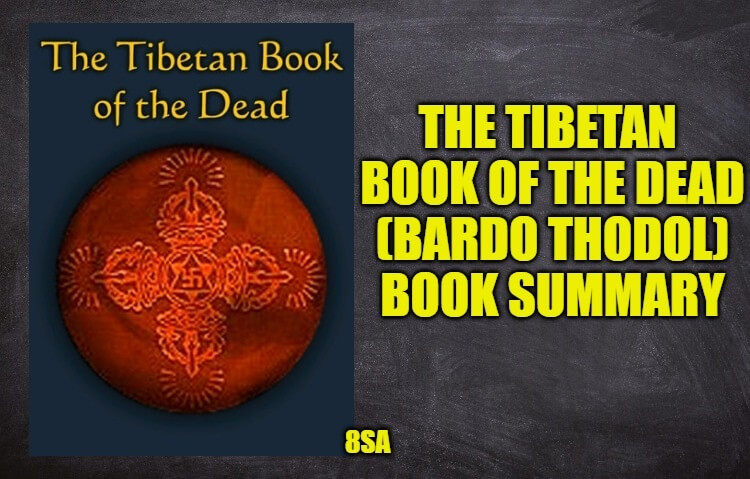What is the summary of the book The Tibetan Book of the Dead (Bardo Thodol)? Information about the summary, characters of The Tibetan Book of the Dead (Bardo Thodol).

The Tibetan Book of the Dead (Bardo Thodol)
The Tibetan Book of the Dead is a text that outlines the process of dying and the afterlife according to the Tibetan Buddhist tradition. The book is known as Bardo Thodol in Tibetan, which translates to “Liberation Through Hearing During the Intermediate State”. It is considered one of the most important works in Tibetan Buddhism and has been widely translated and studied in the West.
The book provides guidance for individuals who are in the process of dying, as well as for those who have already died and are navigating the intermediate state, or bardo, before being reborn. It is believed that during this intermediate state, the consciousness of the deceased experiences a series of visions and experiences that can either lead to enlightenment or further suffering and rebirth.
The text is divided into several sections that correspond to different stages of the dying process and the intermediate state. These sections include instructions for preparing for death, descriptions of the experiences that the consciousness may encounter during the bardo, and guidance on how to attain liberation and avoid rebirth.
The Tibetan Book of the Dead is based on the teachings of the Tibetan Buddhist master Padmasambhava, who is believed to have hidden the text in the 8th century, and later discovered by another Tibetan master named Karma Lingpa in the 14th century.
Overall, the book serves as a guide for individuals seeking liberation from the cycle of birth, death, and rebirth, and offers a unique perspective on death and the afterlife from the Tibetan Buddhist tradition.
Summary
The Tibetan Book of the Dead, also known as Bardo Thodol in Tibetan, is a sacred text of Tibetan Buddhism. It is believed to have been written in the 8th century by the renowned Tibetan Buddhist master Padmasambhava, also known as Guru Rinpoche, and was rediscovered by another Tibetan master named Karma Lingpa in the 14th century. The text provides guidance for individuals during the process of dying and navigating the afterlife, which is referred to as the intermediate state, or bardo.
The book is divided into three main sections: the Chikhai Bardo, the Chönyid Bardo, and the Sidpa Bardo. These three sections correspond to different stages of the dying process and the intermediate state.
The Chikhai Bardo is the stage of dying and includes instructions for preparing for death. This section describes the various signs that indicate the beginning of the dying process and provides guidance on how to prepare for it. It is believed that the dying person’s consciousness goes through various stages, such as the dissolution of the elements and the dissolution of the senses. The text provides detailed descriptions of these stages and how to recognize them.
The Chönyid Bardo is the stage of the intermediate state and includes instructions for navigating the visions and experiences that the consciousness may encounter during this time. It is believed that during the intermediate state, the consciousness experiences a series of visions and experiences that can either lead to enlightenment or further suffering and rebirth. The text provides guidance on how to recognize these visions and experiences and how to use them to attain liberation.
The Sidpa Bardo is the stage of rebirth, where the consciousness is reborn into a new existence. This section includes instructions on how to avoid rebirth and attain liberation from the cycle of birth, death, and rebirth. It is believed that the consciousness has a period of opportunity during the intermediate state to attain liberation, and the text provides guidance on how to do so.
The Tibetan Book of the Dead also includes prayers, mantras, and visualizations that are intended to help the dying person and their loved ones during the dying process and the intermediate state. These practices are designed to support the dying person’s consciousness and help them attain liberation.
The text has had a significant impact on Tibetan Buddhism and has been widely studied and practiced in the West. It offers a unique perspective on death and the afterlife and provides guidance for individuals seeking liberation from the cycle of birth, death, and rebirth. Overall, the Tibetan Book of the Dead serves as a powerful tool for understanding and navigating the dying process and the afterlife.
Characters
The Tibetan Book of the Dead does not have any particular characters in the traditional sense, as it is a guidebook rather than a narrative work. However, it does reference various Buddhist deities and concepts, which are important to understanding the teachings of the text. These include:
- Padmasambhava/Guru Rinpoche – The primary figure associated with the Tibetan Book of the Dead. Padmasambhava is believed to have written the text and is revered as a highly realized master and teacher.
- Yama – The lord of death in Buddhist mythology. Yama is responsible for judging the deceased and deciding their fate in the afterlife.
- Dharmakaya – The ultimate nature of reality and the highest level of realization in Buddhism.
- Sambhogakaya – The level of realization in which the Buddha’s qualities and wisdom are experienced directly.
- Nirmanakaya – The level of realization in which the Buddha appears in physical form to benefit sentient beings.
- Tara – A female bodhisattva associated with compassion and protection. She is often depicted with multiple arms and eyes.
- Avalokiteshvara – A male bodhisattva associated with compassion and wisdom. He is often depicted with multiple arms and eyes.
- Vajrayogini – A female deity associated with the Vajrayana or “diamond” path of Buddhism. She is often depicted in a wrathful form, symbolizing the power to overcome negative emotions.
- Mandala – A symbolic representation of the Buddhist universe and the path to enlightenment.
- Mantras – Sacred sounds or phrases used for meditation and recitation in Buddhist practice.